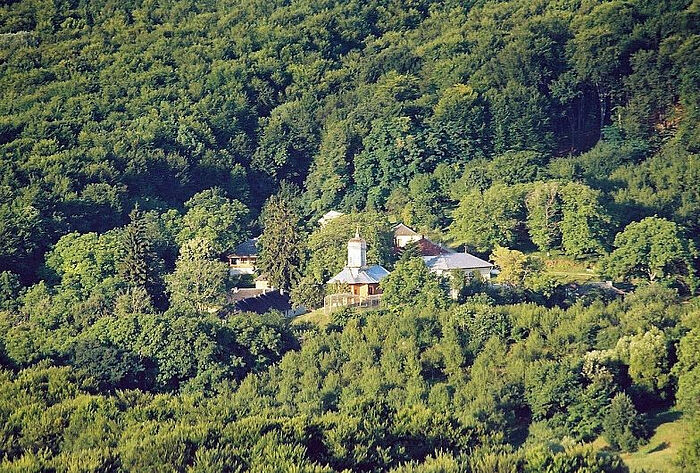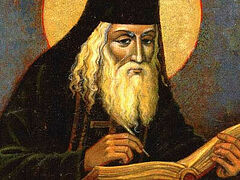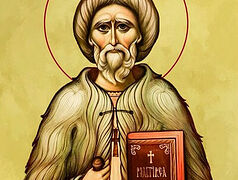A young monk from Russia
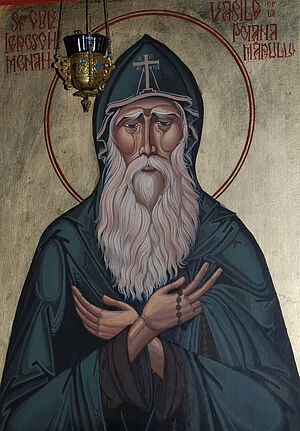 St. Basil of Poiana Marului He came here on foot, of course. More than 600 miles. A boy monk coming from the east, thin, tall, fragile, with a bundle on his back and a cross in his hand. He left through the gates of a Russian monastery and walked through deserted places, not suspecting that he would change the Orthodox world. He made a way for himself through the impassable Dnieper forests, through the scarred lands of the Ukraine of the 1700s, when the Orthodox faith was persecuted, up to the prohibition of the eremitic life—and on and on through the picturesque hills of Moldavia, caressed by a pale and dizzying sun. His cassock was already tattered, and his feet ached from wounds, but he ever looked into the distance, peering at the horizon, waiting to see the first silhouettes of the mountains.
St. Basil of Poiana Marului He came here on foot, of course. More than 600 miles. A boy monk coming from the east, thin, tall, fragile, with a bundle on his back and a cross in his hand. He left through the gates of a Russian monastery and walked through deserted places, not suspecting that he would change the Orthodox world. He made a way for himself through the impassable Dnieper forests, through the scarred lands of the Ukraine of the 1700s, when the Orthodox faith was persecuted, up to the prohibition of the eremitic life—and on and on through the picturesque hills of Moldavia, caressed by a pale and dizzying sun. His cassock was already tattered, and his feet ached from wounds, but he ever looked into the distance, peering at the horizon, waiting to see the first silhouettes of the mountains.
Mountains! All his thoughts were focused on them. How long it had been since he’d seen them! The sacred mountains of Moldovlachia, which he heard about from venerable Kievan monks (this is “one of the most flourishing corners of the Orthodox world, where the monastic life is much deeper and more intense than in Russia and Greece,” as they wrote in that era), the place where the Carpathians turn towards the west, forming a mystical “bend,” where colossal forces are concentrated; a place where schema monasticism and hesychasm continued to exist in undistorted form since the third century, in succession from the first Christians.
And so, in 1708, the young, sixteen-year-old novice Basil Berzukov finally stopped before these mountains. A boy monk who years later would become St. Basil of Poiana Marului.
He stood somewhere there and after a long journey looked at the mountains. And I’m standing here, several miles from the city of Focșani, looking at these fantastic blue silhouettes of the Buzău and Vrancea ridges1 and thinking about what he once saw.
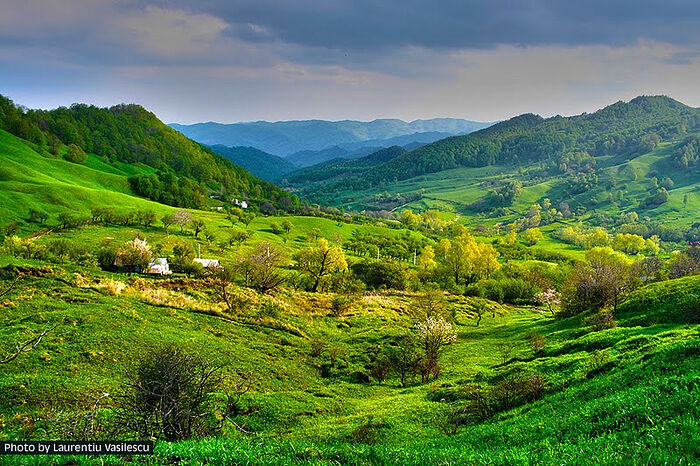 In the vicinity of the village of Bisoca on the border of Buzău and Vrancea Counties. Photo: Laurentiu Lari
In the vicinity of the village of Bisoca on the border of Buzău and Vrancea Counties. Photo: Laurentiu Lari
He reverently entered under the shadow of these mountains, as one enters a church—the Romanian mountains, where he would spend the rest of his life.
St. Basil the Carpathian is known today throughout the Orthodox world. “The Carpathian man of prayer,” as he’s also known. Some researchers claim that although he was born in Russian Poltava, he was from a Romanian family that fled to Russia together with Cantemir and longed for the Moldavian lands, and so he came here.2 It doesn’t matter. He is ours forever, a Vrancean—he’s buried in the wilds of the Wallachian Mountains,3 and his work was continued in the Holy Spirit by thousands of great Romanian spiritual fathers and saints who followed his example, the monastic school with its unceasing prayer of the heart. Today, St. Basil is one of the greatest Romanian saints of all ages.
Dălhăuți. “Every day we walk upon the footsteps of a saint…”
Monasteries that no longer exist: Traisteni, Poiana Schiopului… I can hardly even find the villages that bear their names today, at the foot of the mountains from the side of Râmnicu Sărat. People, even pious old men, whiling away the hours under the walls of ancient churches, know little about this saint who initially labored in the monasteries here—which, however, no longer exist today.
Perhaps higher up, in the mountains, people know about him, in Poiana Marului, since he’s known as St. Basil of Poiana Marului? But that’s far from here, in the mountains above the village of Bisoca. Poiana Marului, or Apple Glade, is the name of the monastery on the bank of the Rymnik River, which still has to be crossed by fording a car, but there isn’t a single bridge there, and then it takes a long time to climb the mountain along the dirt road. Yes, it’s far away, but I’ll definitely get there. In the meantime—Dălhăuți.
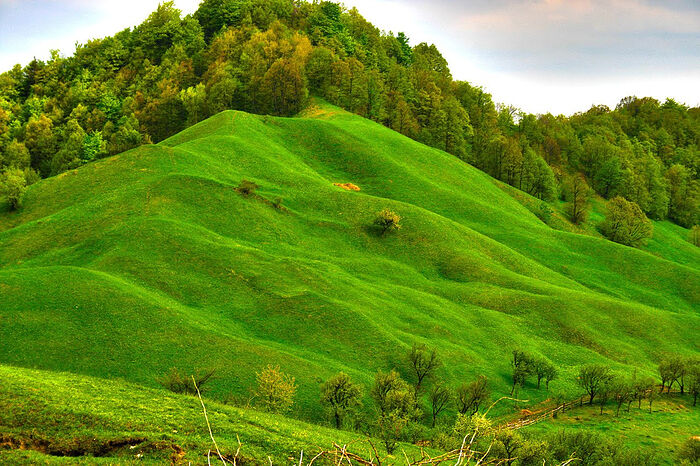 Mountains near the village of Bisoca. Photo: Laurentiu Lari
Mountains near the village of Bisoca. Photo: Laurentiu Lari
A large monastery, hidden in the centuries-old forests at the foot of the Vrancea Mountains. It was founded in 1464! It’s unfair that so little is known about it today, especially since it’s so beautiful. St. Basil labored here first, for twenty whole years, on Romanian soil; here he became a hieromonk, then an abbot, and nourished hundreds of outstanding monks, great men of prayer, who filled all the surrounding hermitages with their cells.
The forest here is really amazing. A nature reserve, untouched by man. Gigantic yews. Cedars forgotten by time. Oak trees, hundreds of years old. An emerald, boundless, impenetrable thicket. This whole forest once “saw” the saint. And he, the saint, knew this forest. A thicket of trees surrounds the monastery, coming right up to the white walls, like a huge green wall, from beyond which comes a symphony of mysteries and whispers.
“This forest, yes… Can you imagine that it was exactly the same back then? And what place could be better suited for a monastery than this blessed glade?” says Mother Rafaela, our guide to the Dălhăuți Paradise, still amazed by the splendor even after nine years, during which she’s never left the monastery. “We’ve been given the joy of living here, and we have to take care of this place. We have a huge responsibility: After all, every day we walk upon the footsteps of a saint. The grace of this place is alive here, the spirit of prayer is alive. And in the end, it will be asked of us: ‘What have you done with this happiness? What have you done with what was given to you?’”
The ancient stone church, known as “Among the Graves,” is the one where St. Basil served three centuries ago. The gilded iconostasis that his fingers touched… The wonderworking icon of the Most Holy Theotokos before which he prostrated himself so many times. This is an icon known throughout the Christian world, that spurted blood when a Turk struck the faces of the Most Holy Mother and the God-Child with a scimitar in Constantinople, and which then miraculously returned home by itself, carried on the waves of the Black Sea and overshadowed by angels, stopping right at the feet of the same Romanian monk whom the Turks took it from.
 The Church of the Lifegiving Spring at Dălhăuți Monastery where St. Basil served
The Church of the Lifegiving Spring at Dălhăuți Monastery where St. Basil served
Mother Rafaela gently touches the scars on the faces of the Most Holy Theotokos and the Christ Child.
“Look, the wound is still completely fresh. It’s a living body…”
She tells me that there was living flesh there, that the edges of the deep gashes were healing, just like a human wound. The scarred faces of the Mother and her Divine Son… You can’t look at them without a shudder. It’s painful—tragic, even. Especially at the Child, Who was struck with such cruelty on His Divine face…
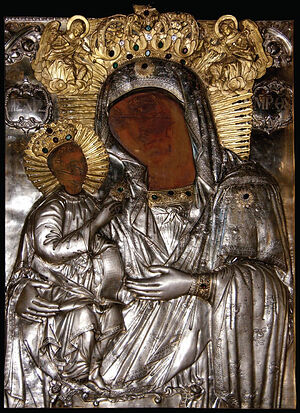 The wonderworking Anufiana Icon of the Most Holy Theotokos from Dălhăuți Monastery However, the pain of this living image has healed thousands of people! Mother Rafaela, a thirty-six-year-old nun, knows people who were sick with cancer, who were paralyzed, infertile, who were called here by the icon. They simply couldn’t live without seeing these faces. They came here again and again from different places, from afar, obeying the Divine call. And they were healed.
The wonderworking Anufiana Icon of the Most Holy Theotokos from Dălhăuți Monastery However, the pain of this living image has healed thousands of people! Mother Rafaela, a thirty-six-year-old nun, knows people who were sick with cancer, who were paralyzed, infertile, who were called here by the icon. They simply couldn’t live without seeing these faces. They came here again and again from different places, from afar, obeying the Divine call. And they were healed.
Some art historians say it was painted by the Apostle Luke himself, or one of his direct disciples. In any case, when St. Basil came here, the icon had already been in the Vrancea mountains for a long time. The saint knew where he was going. He felt called by God. The same was felt by his famous disciple at Dălhăuți, St. Paisius (Velichkovsky), who also came here from the Poltava region, who was to become one of the greatest Christian saints. The same was felt by many other Slavic schemamonks who went on a genuine “Russian-Ukrainian monastic emigration to the holy Romanian places,” thus testifying that the Romanian monasticism of those days was flourishing more than Russian monasticism at that time and was the strongest in all of Orthodoxy.
St. Basil was called here by the icon. That’s what the old-timers around Dălhăuți believe today. After all, the icon brought him from Russia. His hands touched it. His tears watered it.
Paisius: the meeting of two saints
The nuns of Dălhăuți say that the power of the icon and St. Basil both protect the monastery today. And it’s real, it’s even scientifically provable.
Geodetic studies show that the ground here is so movable that the buildings should have collapsed long ago. Earthquakes are a common occurrence here, according to Mother Rafaela, who doesn’t even flinch when her cell is constantly shaken by tremors.4
The walls of the third church, the newer one, erected in 1850, were cracked to the very foundation by these frequent and powerful earthquakes. It couldn’t endure, because it was “weaker in spirit.” And in the ancient church, where St. Basil served, not a single brick has moved from its place.
We leave, and Mother Rafaela again casts her gaze to the forest. She says that in these forests, a good ways away, you can still find the remains of the cells of the ancient hermits. After all, St. Basil had forty close hermit-disciples. And all were in holy orders. All as one. A truly elite monastic force. But besides them, other hermits, hundreds of schemamonks, drawn here by the grace of the great confessor, always labored in the vicinity of the monastery. Even today, the nuns often find bricks, century-old logs, old Church utensils, and even human remains in the forest. They come out of the ground year after year.
Behind the church cracked by an earthquake, a lawn stretches out like an amphitheater. Here, in this “natural hall,” about where there’s a bench that Mother Rafaela and I were sitting on, once sat St. Basil, teaching his numerous disciples. And after him, other venerable abbots, his successors, taught here. The monastic school existed here for a long time uninterrupted, until the very last times, until the establishment of the communist regime (1947), when a hieromonk named Nazarie (Sepunaru) was leading the theological seminary in the green amphitheater, preaching and instructing in the spirit of St. Basil. Monasticism has never been wanting here, for more than seventeen centuries.
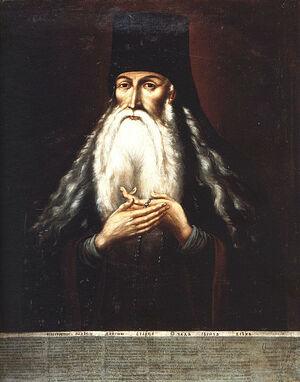 St. Paisius (Velichkovsky) And here, in Dălhăuți, Elder Basil received his young disciple, Paisius (Velichkovsky), who also came from Poltava, a few decades after him. The epochal meeting of two great saints, which is still commemorated in the monastery today, as though it happened yesterday. From the communications of her predecessors, Mother Rafaela can somewhat imagine how it happened: a timid, thing young man, weak in health, who labored in the kitchen, but not too successfully, since “his mind was elsewhere,” and wept like a child every time his bread burned in the oven, although the Elder never scolded him.
St. Paisius (Velichkovsky) And here, in Dălhăuți, Elder Basil received his young disciple, Paisius (Velichkovsky), who also came from Poltava, a few decades after him. The epochal meeting of two great saints, which is still commemorated in the monastery today, as though it happened yesterday. From the communications of her predecessors, Mother Rafaela can somewhat imagine how it happened: a timid, thing young man, weak in health, who labored in the kitchen, but not too successfully, since “his mind was elsewhere,” and wept like a child every time his bread burned in the oven, although the Elder never scolded him.
This discipleship of the young Paisius in the mountains of Vrancea was decisive for the fate of the future saint of Wallachia. And it’s no surprise that four years after he left for Mt. Athos, Elder Basil himself went to the Greek land to see his disciple, whom he deeply cared for, and in the spring of 1750, he tonsured him into monasticism and clothed him in the small schema.
To be continued…

